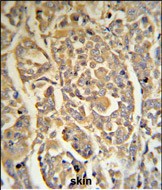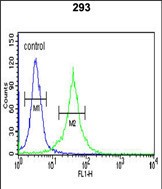DCD Antibody (C-term)
Purified Rabbit Polyclonal Antibody (Pab)
- SPECIFICATION
- CITATIONS: 1
- PROTOCOLS
- BACKGROUND

Application
| FC, IHC-P, WB, E |
|---|---|
| Primary Accession | P81605 |
| Reactivity | Human |
| Host | Rabbit |
| Clonality | Polyclonal |
| Isotype | Rabbit IgG |
| Calculated MW | 11284 Da |
| Antigen Region | 74-103 aa |
| Gene ID | 117159 |
|---|---|
| Other Names | Dermcidin, 34--, Preproteolysin, Survival-promoting peptide, DCD-1, DCD, AIDD, DSEP |
| Target/Specificity | This DCD antibody is generated from rabbits immunized with a KLH conjugated synthetic peptide between 74-103 amino acids from the C-terminal region of human DCD. |
| Dilution | FC~~1:10~50 IHC-P~~1:50~100 WB~~1:1000 E~~Use at an assay dependent concentration. |
| Format | Purified polyclonal antibody supplied in PBS with 0.09% (W/V) sodium azide. This antibody is prepared by Saturated Ammonium Sulfate (SAS) precipitation followed by dialysis against PBS. |
| Storage | Maintain refrigerated at 2-8°C for up to 2 weeks. For long term storage store at -20°C in small aliquots to prevent freeze-thaw cycles. |
| Precautions | DCD Antibody (C-term) is for research use only and not for use in diagnostic or therapeutic procedures. |
| Name | DCD (HGNC:14669) |
|---|---|
| Function | [DCD-1]: Found in sweat, has an antimicrobial activity during early bacterial colonization (PubMed:11694882, PubMed:23426625). The secreted peptide assembles into homohexameric complexes that can associate with and also insert into pathogen membranes (PubMed:23426625). Once inserted in bacteria membranes forms anion channels probably altering the transmembrane potential essential for bacterial survival (PubMed:23426625). Highly effective against E.coli, E.faecalis, S.aureus and C.albicans (PubMed:11694882). Optimal pH and salt concentration resemble the conditions in sweat (PubMed:11694882). Also exhibits proteolytic activity, cleaving on the C-terminal side of Arg and, to a lesser extent, Lys residues (PubMed:17448443). |
| Cellular Location | Secreted [DCD-1]: Secreted. Membrane; Peripheral membrane protein. Membrane; Single-pass membrane protein. Note=The secreted peptide assembles into homohexameric complexes that can probably associate with pathogen membranes and also insert into these membranes where they behave as channels. |
| Tissue Location | Detected in urine (at protein level) (PubMed:25326458, PubMed:36213313, PubMed:37453717). Constitutively expressed in eccrine sweat gland cells (at protein level). Secreted into the sweat at a concentration of 1-10 micrograms/ml |

Provided below are standard protocols that you may find useful for product applications.
Background
DCD is a secreted protein that is subsequently processed into mature peptides of distinct biological activities. The C-terminal peptide is constitutively expressed in sweat and has antibacterial and antifungal activities. The N-terminal peptide, also known as diffusible survival evasion peptide, promotes neural cell survival under conditions of severe oxidative stress. A glycosylated form of the N-terminal peptide may be associated with cachexia (muscle wasting) in cancer patients.
References
Todorov,P.T., J. Biol. Chem. 272 (19), 12279-12288 (1997)
If you have used an Abcepta product and would like to share how it has performed, please click on the "Submit Review" button and provide the requested information. Our staff will examine and post your review and contact you if needed.
If you have any additional inquiries please email technical services at tech@abcepta.com.














 Foundational characteristics of cancer include proliferation, angiogenesis, migration, evasion of apoptosis, and cellular immortality. Find key markers for these cellular processes and antibodies to detect them.
Foundational characteristics of cancer include proliferation, angiogenesis, migration, evasion of apoptosis, and cellular immortality. Find key markers for these cellular processes and antibodies to detect them. The SUMOplot™ Analysis Program predicts and scores sumoylation sites in your protein. SUMOylation is a post-translational modification involved in various cellular processes, such as nuclear-cytosolic transport, transcriptional regulation, apoptosis, protein stability, response to stress, and progression through the cell cycle.
The SUMOplot™ Analysis Program predicts and scores sumoylation sites in your protein. SUMOylation is a post-translational modification involved in various cellular processes, such as nuclear-cytosolic transport, transcriptional regulation, apoptosis, protein stability, response to stress, and progression through the cell cycle. The Autophagy Receptor Motif Plotter predicts and scores autophagy receptor binding sites in your protein. Identifying proteins connected to this pathway is critical to understanding the role of autophagy in physiological as well as pathological processes such as development, differentiation, neurodegenerative diseases, stress, infection, and cancer.
The Autophagy Receptor Motif Plotter predicts and scores autophagy receptor binding sites in your protein. Identifying proteins connected to this pathway is critical to understanding the role of autophagy in physiological as well as pathological processes such as development, differentiation, neurodegenerative diseases, stress, infection, and cancer.



